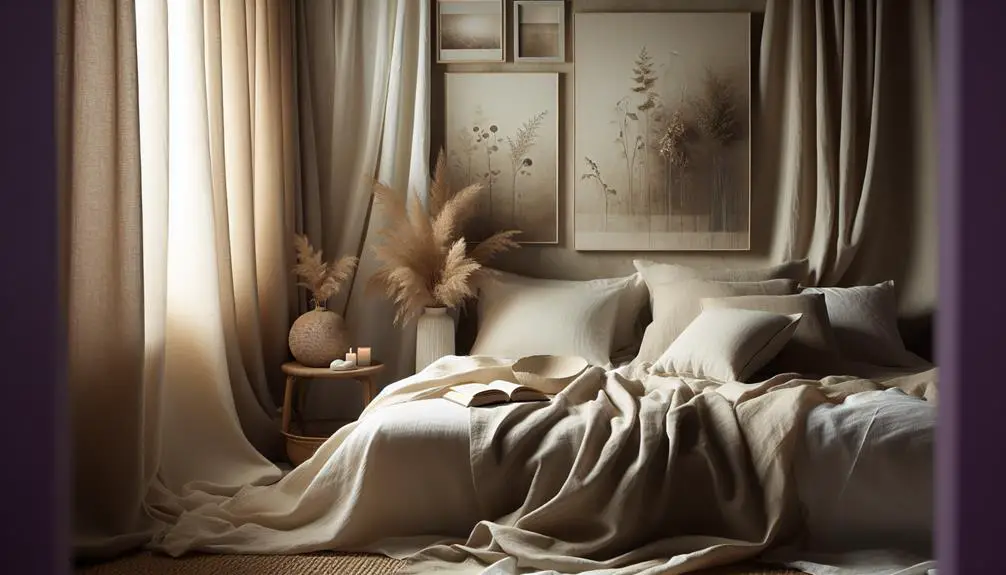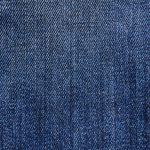In my quest for the perfect linen, I've learned that it's not just about snagging a high thread count or the cheapest deal out there. It's a delicate balance of quality, feel, and durability that matters. From understanding the nuances of fabric weight to deciphering the jargon around sustainable sources, there's a lot to unpack. And don't even get me started on navigating color accuracy and those pesky care instructions. But here's the kicker: sorting through all this info can actually lead you to linen that feels like a dream and lasts a lifetime. So, where do we even begin?
Table of Contents
Key Takeaways
- Assess the linen's composition, preferring 100% flax for authenticity and quality.
- Consider fabric weight based on the intended use, from light garments to heavy upholstery.
- Look for certifications like European certification to ensure durability and ethical sourcing.
- Examine the weave and texture for indicators of quality, such as tightness and natural slubbiness.
- Understand care requirements to maintain linen's quality and longevity over time.
Understanding Thread Count
When shopping for linen, it's crucial to understand that thread count, which is the number of threads per square inch, isn't the only marker of quality. We often get caught up in the numbers game, thinking higher thread counts mean superior linens. But here's the skinny: it's not that straightforward, especially with linen.
Linen's magic lies in its natural fibers, which are typically thicker. So, when you hear that quality linen has a thread count of 80-150, don't balk. These numbers don't mean it's low-grade. Quite the opposite, actually. This range is ideal for achieving that perfect blend of breathability and durability, which is what high-quality linen is all about.
Understanding thread counts is more about getting a feel for the fabric's overall quality. It's a factor, sure, but it's just one piece of the puzzle. The takeaway? Don't let high thread counts blind you. Quality linen often prides itself on lower counts due to its thicker, more robust fibers. This is what contributes to its luxurious feel and longevity. So, next time you're linen shopping, remember, it's not all about the numbers.
Evaluating Fabric Weight
After grasping thread count, let's shift focus to another key aspect of linen: fabric weight. You see, fabric weight is all about how much the linen weighs, measured in grams per square meter (GSM). This little detail is a game-changer, especially when you're picking linen for specific uses.
If you're eyeing something light and breezy, maybe for a cool shirt or dress, you're looking at linen with a fabric weight anywhere from 90-150 GSM. It's perfect for those airy garments that feel like a soft whisper against your skin.
Now, if you're after versatility, medium weight linen is your go-to. We're talking 150-250 GSM. It's the sweet spot for a bunch of clothing items, giving you that perfect balance of durability and comfort. This is where most of your everyday linen apparel falls.
And for the heavy-duty stuff? That's where heavy weight linen comes into play, tipping the scales over 250 GSM. Think durable upholstery or those home textiles that need to stand up to a bit more wear and tear. It's robust, it's resilient, and it's exactly what you need for items that are going to see a lot of use.
Choosing the right fabric weight is crucial. It's all about matching the linen's weight per square meter to your intended use. Trust me, it makes all the difference.
Composition and Quality
Diving into the heart of linen, its composition and quality are key to finding the perfect piece. When I'm on the hunt for quality linen, I always check the label for 100% flax or a flax blend. This isn't just about being fancy; it's about getting the real deal. The weight of the linen is a big tell too. I lean towards medium to heavy weights because they just last longer.
Here's a quick table to break it down:
| Feature | Why It Matters |
|---|---|
| 100% Flax Linen | Ensures authenticity and quality |
| Weight | Heavier means more durable |
| Weave | Tight and even equals sturdiness |
| Texture | Slightly slubby = natural fibers |
| Source of Fibers | Flax fibers are the gold standard |
Quality linen has this unique, slightly slubby texture that I absolutely love. It's like you can feel the naturalness. And the weave? It's gotta be tight and even. That's when you know it's made to last. Prioritizing flax fibers isn't just about snobbery; it's about investing in something that's authentically superior.
Care and Maintenance Tips
So, you've picked out some gorgeous linen pieces, and now it's time to talk about keeping them in tip-top shape.
I'll walk you through the basics of washing, ironing, and storing your linen to make sure it lasts.
Stick with me, and you'll be a linen care pro in no time.
Washing Best Practices
I've found that the key to keeping my linen clothes in top-notch condition starts with how I wash them. Always checking the care instructions is my first step. I stick to machine washing my linen fabric on a gentle cycle with cold water. This approach helps maintain its quality without causing damage.
After washing, I opt to air dry my pieces instead of tossing them in the dryer. This method not only preserves the fabric but also prevents excessive wrinkling, which can be a real pain to iron out later.
I've learned that treating linen with a little extra care during the washing process goes a long way in keeping my garments looking their best.
Ironing and Storage Tips
Once you've got your linen items washed and air-dried, it's time to tackle ironing and proper storage to keep them looking sharp. Here are my go-to ironing tips and storage strategies for linen fabric:
- Iron while slightly damp: This eases out wrinkles and maintains the fabric's quality. Don't wait till it's bone dry.
- Avoid high heat: Linen and high heat aren't best friends. Use a medium setting to prevent scorching.
- Use a steamer: It's a great alternative, especially for linen garments, to avoid direct heat damage.
- Follow care instructions: Sounds basic, but it's crucial. Proper washing and air-drying are the foundations of linen care, making ironing and storage a breeze.
Color Accuracy and Selection
When I started looking for the perfect linen, I quickly learned that colors on my screen didn't always match the real thing.
It's a good move to ask for a swatch first to make sure what you see is what you get. Plus, with so many colors available, finding the right shade means you won't have to settle for something close enough.
Color Consistency Online
Often, the colors you see on your screen don't exactly match the real-life colors of linen fabric due to monitor settings and lighting conditions. It's a common hiccup when shopping online for those perfect colors and patterns. Here's how you can get around it:
- Always request a free linen swatch before making a big purchase. It's the best way to ensure what you're seeing is what you'll be getting.
- Understand that dye lots can vary slightly; custom options might be your friend if you're after consistency.
- Dive into the detailed, zoomed-in images provided online to check out the weave and texture, which can give you better clues about the true color.
- Remember, lighting plays a huge role, both in photos and in your home.
Wide Palette Availability
In today's market, you'll find an impressive range of colors available in linen fabrics, ensuring you can pick just the right shade for your project.
But here's a heads-up: computer screens can be tricky, often showing colors a bit off due to lighting, monitor settings, and photography. That's why snagging a free linen swatch is a game-changer. It lets you see the real deal, ensuring what you pick matches your expectations spot on.
Plus, when you're aiming for consistency, going for custom dye lots is a smart move. They keep the color uniform across your project, minimizing surprises.
And don't forget to zoom in on those images. It's a great way to check out the weave and texture, giving you a better sense of the color accuracy.
The Importance of Weaves
Understanding the different weaves in linen, like plain, twill, and herringbone, is key to choosing the right fabric for your needs. When I'm picking out linen fabric, I always pay close attention to the weave choice because it's not just about the look; it's how the fabric feels and behaves. Let me break it down real quick:
- Plain weave is your go-to for simplicity and durability. It's pretty much the workhorse of linen fabrics, offering a balanced blend of breathability and strength. Ideal for daily wear items.
- Twill weave kicks things up a notch with its diagonal pattern. This weave is what you want for heavier linen items. It drapes beautifully and tends to be more wrinkle-resistant, making it a solid choice for trousers or jackets.
- Herringbone weave stands out with its distinctive V-shaped pattern. It's all about adding texture and a touch of elegance to your linen collection. Perfect for those pieces where you want to make a statement.
- The choice of weave affects not just the appearance but also the breathability, drape, and overall feel of the garment.
Getting savvy with these details ensures I'm always happy with my linen purchases.
Fabric Types and Textures
Now, let's talk about what sets different types of linen apart, focusing on blends, texture, and how these factors impact care and durability.
I've found that understanding the variety in texture not only helps in picking the right fabric but also in knowing how to keep it looking great.
Plus, getting a handle on the various blends can really make a difference in finding the perfect linen for your needs.
Linen Blend Differences
Let's dive into how linen blends mix things up with other fibers, changing the game in fabric texture and features. When you're eyeing linen blends, remember you're not just getting flax linen's iconic feel; you're stepping into a world where:
- Cotton-Linen Mixes: These bring together cotton's breathability and linen's durability, creating a super versatile fabric.
- Linen-Synthetic Fusions: Aimed at your wallet's heart, these blends offer stretch and less wrinkling at a friendlier price.
- Softness vs. Strength: Adding other fibers to linen can make it softer and less prone to wrinkling, without sacrificing too much strength.
- Blend Ratios Matter: Higher linen content? Expect more of that natural, breathable texture linen lovers chase after.
Each blend has its own set of perks, making them worth a closer look for any linen enthusiast.
Texture Variability Importance
Diving into the world of linen, we find its texture variability, from slubs to nubs, plays a crucial role in the fabric's appeal and functionality. Linen isn't just about looks; these textures, including the natural imperfections, add a unique character that sets linen fabric apart.
When you're choosing linen, consider the weave—plain, twill, or herringbone can drastically alter the texture, giving each garment a distinct feel. Mixing linen with cotton, silk, or viscose introduces a whole new tactile experience, making the fabric softer or giving it a subtle sheen.
For those after durability and structure, heavyweight linen is your go-to, offering a more substantial texture. And let's not forget textured weaves like jacquard or dobby; they bring visual and tactile richness that's simply unmatched.
Care and Durability Insights
Understanding how to care for and gauge the durability of different linen types and textures can significantly extend their life and appeal. Here's what I've learned:
- Always choose linen made from 100% flax fibers for optimal durability. It's a game-changer.
- Medium to heavy-weight linen is my go-to for increased durability and resistance to those pesky wears and tears.
- I make sure to look for a tight and even weave in linen fabric. This tip alone has saved me from countless disappointments.
- Quality linen has a slightly slubby texture, which not only screams authenticity but also durability.
Proper care is crucial too. I've found that gently machine washing in cold water and air drying keeps my linen fabric looking and feeling fantastic, minimizing wrinkles and maintaining quality.
Sustainability and Source
When it comes to eco-friendly fabrics, linen tops the list for its sustainability and source. So, here's the scoop on why and how to pick the best linen for you and the planet.
First off, choosing linen made from flax fibers is a smart move. Why? Because flax is a champ at being a renewable resource. It hardly needs any water or pesticides to grow. That's a big win for the environment.
Now, let's talk about where your linen comes from. European flax linen is the way to go. Europe's got a rep for producing top-notch flax fibers, meaning your linen's not just durable but also of superior quality. And, if you're all in on protecting the planet, organic linen should be on your radar. It guarantees your fabric's clean from nasty chemicals and pesticides.
It's also worth checking out companies that walk the talk on sustainability. I'm talking about those using green energy and cutting down on waste during production. Plus, linen's biodegradable and lasts ages, cutting down on the need to keep replacing stuff. So, you're not just investing in quality but also in a better planet.
Checking Customer Reviews
After exploring the sustainability side of linen, let's now check out what customers have to say about their experiences. You know, diving into customer reviews is like hitting a goldmine when you're eyeing linen fabric online. It's not just about scrolling through star ratings; it's about getting the nitty-gritty on what really matters.
Here's what I always look for:
- Quality and Durability: I skim through reviews to find mentions of how the fabric holds up. Are people praising its strength and longevity, or are they warning about it falling apart after a few washes?
- Comfort and Texture: Linen's all about comfort. I look for feedback on whether the fabric feels soft and breathable against the skin.
- Color and Accuracy: Nothing's worse than expecting one shade and getting another. I check if customers are happy with the color they received and if it stays true after washing.
- Value for Money: Lastly, I weigh if people feel they got their money's worth. It's about balancing cost with quality, and I rely heavily on customer insights for this.
Sifting through customer reviews gives me a clearer picture of what to expect. It's about getting firsthand accounts from those who've already taken the plunge.
Certifications and Standards
Diving into the world of linen, it's crucial to talk about the certifications and standards that ensure you're getting the best bang for your buck. When scouting for top-notch linen fabric, the Oeko-Tex certification is a game-changer. This label means your linen is free from any nasty chemicals and toxins, making it safer for you and the environment.
Then there's the European Flax certification, a big deal if you're all about sustainability and ethical sourcing. This certifies that the linen comes from a good place, both literally and figuratively. For those who lean towards the organic side of life, the GOTS (Global Organic Textile Standard) is your best friend. It guarantees that your linen is crafted from organic fibers, adhering to strict environmental and social criteria.
Another essential certification is the OEKO-TEX Standard 100. This ensures the linen fabric has passed rigorous tests for harmful substances, reassuring you it's safe for human use. And if you're keen on quality, look for the Masters of Linen certification, indicating the linen is made in Europe, adhering to high production standards. These certifications are your roadmap to making informed, responsible linen purchases.
Price Versus Quality
Navigating the tricky waters of linen shopping, it's important to remember that a higher price tag doesn't always mean you're getting better quality. We're all after that perfect blend of comfort and durability in our linen garments, but the price can sometimes throw us off the scent.
Here's a quick rundown to keep you savvy:
- Real linen costs more due to its labor-intensive production methods. Unlike synthetic fibers, real linen requires a bunch of hand processes that bump up the price.
- A hefty price tag isn't a quality guarantee. It's easy to assume the most expensive option is the best. However, don't let price alone guide you.
- Not all high-priced linen is created equal. Some brands might upcharge without matching quality improvements. It's about finding the sweet spot between cost and quality.
- Certifications matter. European certified linen, for instance, is a solid indicator of quality and durability, even if it's pricier.
Frequently Asked Questions
How Can You Tell Good Quality Linen?
To tell good quality linen, I look for 100% linen on the tag, natural imperfections, and a coarse texture that softens over time. I also consider the linen's origin, favoring European sources.
How Do I Choose Linen?
I'd check for 100% linen on the materials tab, look for natural imperfections and nubs, and prefer European sources. I'd also opt for reputable brands like LinenMe for quality assurance in my linen choices.
What Type of Linen Is the Best?
I think the best type of linen is 100% flax fibers. It's durable, has a natural texture, and holds up well. Always check for a tight weave and a bit of slubbiness for authenticity.
How Can You Tell if Something Is 100% Linen?
I always check the label for a "100% Linen" indication to confirm it's genuine. Feeling for a slightly rough texture and looking for tiny nubs in the fabric also help me identify real linen.
- Tetron Fabric for Marine Applications: Durability and Use Cases - June 18, 2025
- Tetron Fabric for Outdoor Furniture: Weather Resistance and Care - June 18, 2025
- Tetron Fabric for Wall Coverings: Style and Application Tips - June 18, 2025







